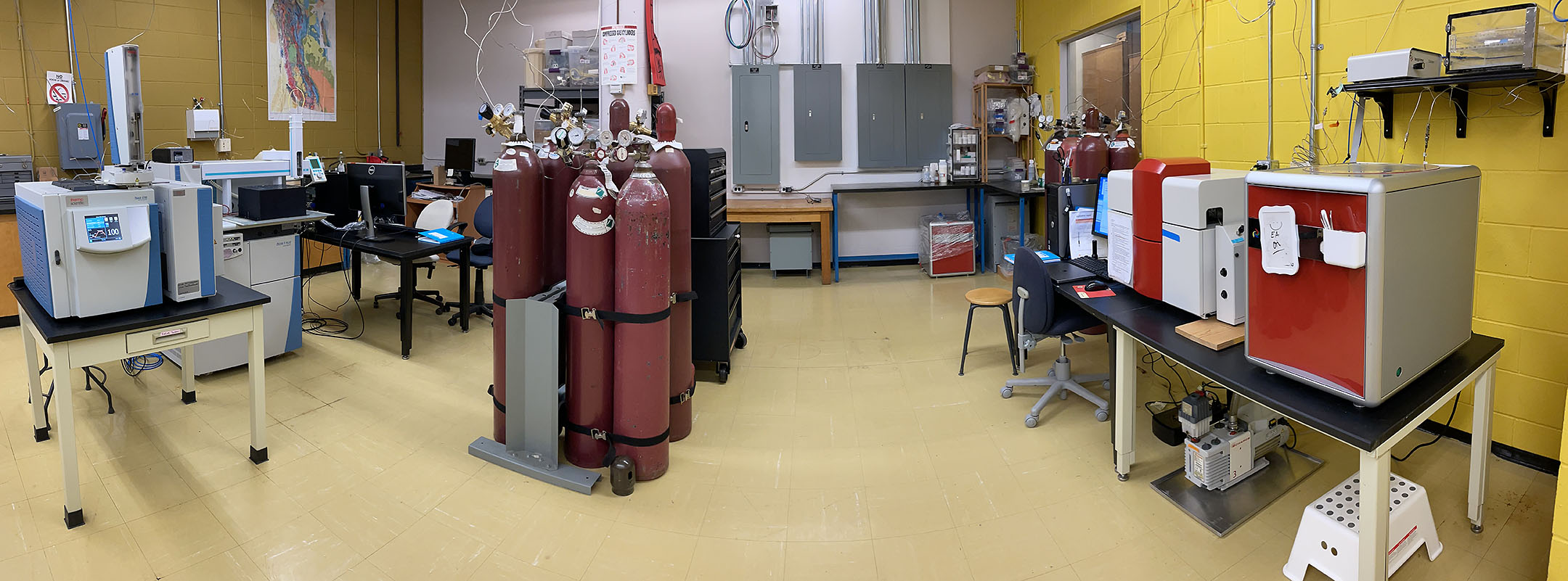PCIGR’s IRMS instruments are used for light stable isotope analyses. Our systems can handle gas, liquid and solid samples from a variety of sample types. If a user requires only elemental data (e.g., for carbon and/or nitrogen), our elemental analyzer (EA) can provide concentration data without isotopic data.
| Make/model | Interface | Peripheral |
| Isoprime 100 | Continuous flow | Elementar Vario Micro Cube EA |
| Thermo Scientific Delta V Plus | Continuous flow | GasBench, IsoLink II GCC (coming 2025) |

Stable Isotope Laboratory at PCIGR. Left: Delta V Plus IRMS with GC and Gasbench. Right: Isoprime 100 with Elementar Vario Micro Cube EA. Photo: K. Chritz
Isoprime 100
The Elementar Vario Micro Cube EA can be used stand-alone for determining elemental concentrations (wt. %) of carbon and nitrogen from solid samples, or used in conjunction with the Isoprime 100 IRMS for determining isotopic ratios (‰ vs standard) of carbon and nitrogen in organic materials.
The Isoprime 100 and Elementar Vario Micro Cube were acquired from the Laboratory of Archaeology (UBC, 2010) and installed at PCIGR in 2022.
The Elementar Micro Cube EA is equipped with the following features:
- 120-place autosampler carousel
- Set up in CN or N analysis mode, depending on sample type
- Flash combustion of samples, typically at 950 ˚C inside the combustion column
- Innovative CO2 adsorption column in lieu of a conventional GC column
- Thermoconductivity detector for elemental concentrations from ppm levels to 100% (detection range for carbon: 0–40 mg)
The Isoprime is equipped with the following features:
- Variable dilutor to control the amount of N2 or CO2 gas entering the IRMS from the EA
- Continuous flow interface (open split)
- Reference gas injector box
- Permanent and electromagnet (1–70 amu)
- 3 Faraday collectors: carbon m/z 44, 45, 46; nitrogen m/z 28, 29, 30
Both the Elementar Vario Micro Cube EA and Isoprime IRMS can analyze a variety of solid sample types, including
- Sediments and soils
- Biological and archaeological materials (e.g., plant matter (except wood), hair/fur, animal tissue, bones and teeth)
- Foods and pharmaceuticals
The Isoprime IRMS has a precision (stdev) of ± 0.1‰ for δ13C and ± 0.2‰ for δ15N (IAEA-600, caffeine).
Contact Dr. Kendra Chritz for details on instrumentation and submitting samples.
Consult the Fees page for analytical costs.
Thermo Scientific Delta V Plus
The Thermo Scientific Delta V Plus is a versatile continuous-flow IRMS for determining carbon, nitrogen and oxygen isotopes in liquid and gaseous samples. Acquired in 2012 by UBC Laboratory of Archaeology and transferred to PCIGR in 2020, the Delta V Plus is connected to a GasBench and an Isolink II gas chromatograph.
The Delta V Plus is equipped with the following features:
- ConFlo IV Universal Continuous Flow Interface
- Sensitivity of 1100 molecules per CO2 ion with continuous flow
- Fast switching magnetic analyzer with ability to measure 3 isotope ratios in a single sample injection
- Faraday collectors for C, N and O isotopes
Interfaced with the Delta V Plus, the GasBench is used for automated acid digestion and analysis of δ13C and δ18O isotopes in biological and archaeological carbonates, including:
- Tooth enamel
- Bone
- Shells
- Paleosol and soil carbonates
- Otoliths
Connected to an IsoLink II Gas Chromatograph-Combustion interface, the Delta V Plus can perform compound-specific isotope analysis (CSIA) of δ13C and δ15N in derivatized liquid samples for:
- Amino acids
- Fatty acids
- Leaf waxes
Notes:
Users are expected to prepare the own derivatized samples for CSIA.
The Delta V Plus system is being optimized and will be ready to accept samples in late 2025. Please check back with us again.
Contact Dr. Kendra Chritz for details on instrumentation and submitting samples.
Consult the Fees page for analytical costs.